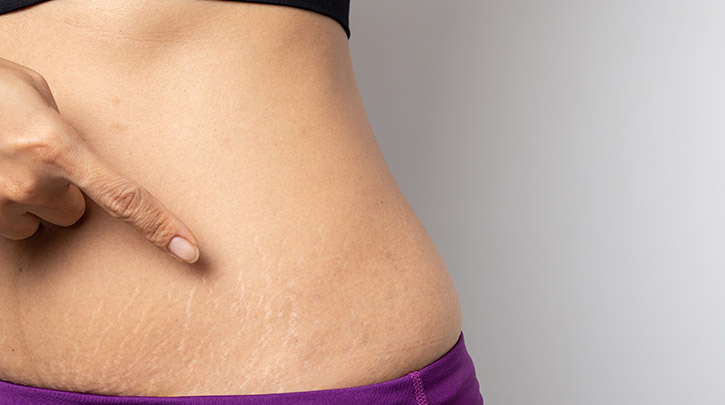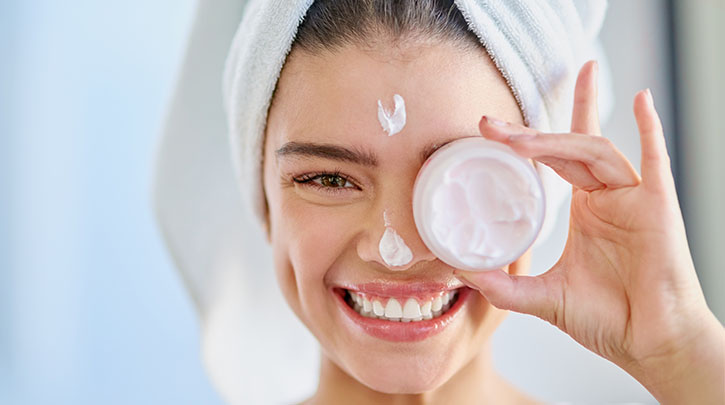
- Global
Get non-surgical solutions for today's top aesthetic concerns with Venus Treatments. Join thousands of satisfied patients worldwide!
- Loading...
- All Regions
Get non-surgical solutions for today's top aesthetic concerns with Venus Treatments. Join thousands of satisfied patients worldwide!

While 90% of women experience stretch marks at some point during their lives—and some men experience them, too—it can still be tough to understand how the remaining 10% and most men seem to dodge such a common occurrence. For those concerned about stretch marks forming or what you might do to reduce the appearance of stretch marks, discover these top factors that most often contribute to their formation and what you can do to avoid them.
A rapid increase in body weight can pose a significant challenge to your skin and is a consistent factor in the appearance of stretch marks. In other words, every stretch mark begins with the stretching of the skin.
As fat or muscle is gained, skin is forced to stretch to accommodate this growth. Unfortunately, skin’s elasticity may restrict it from being able to stretch fast enough, leading to a tear in the collagen structure beneath the skin’s surface. The result is the appearance of a scar-like mark, often pink or brown in color, that appears from the epidermis. It should be noted that this type of tear in the skin does not occur in a physical wound on the skin’s surface, but rather exists in the epidermal layer. For most pregnant women, a surge in weight gain often occurs during the sixth or seventh month of pregnancy, which is when stretch marks tend to show up. In fact, pregnancy is the leading cause of stretch marks among women. Rapid weight gain during puberty in both males and females can also lead to stretch marks, as can rapid muscle gain in bodybuilders or fat gain in those who may be overweight or obese.
As we age, our skin’s natural collagen and elastin levels begin to decline. As a result, it loses its firmness, flexibility, and ability to recover from damage due to a slower skin cell renewal cycle. For these reasons, age can have an impact on stretch mark risk in two ways. First, younger skin is unable to stretch as much as older skin to accommodate rapid weight gain; older skin tends to be looser, allowing for greater weight gain before it begins to stretch. However, when a stretch mark occurs in older skin, it’s less able to repair the damage naturally, meaning the permanent appearance of a stretch mark is much more likely in those who are older. It is worth noting that lifestyle factors can also impact how rapidly skin may age.
Hormones have a significant impact on skin health. A high level of testosterone is one of the key reason’s men’s skin tends to be resistant to stretch marks. Testosterone contributes to the skin’s moisture levels through increased oil production. This naturally healthier hydration level helps to support the skin’s collagen production cycle, allowing for increased elasticity and a lower risk of stretch marks as a result. For women, estrogen has a significant impact on skin health. Balanced estrogen levels help to maintain skin structure and hydration via healthy hyaluronic acid and collagen production levels for a plumper, smoother, and more radiant complexion. Drastic changes in estrogen levels that occur during puberty, pregnancy, and menopause make the skin susceptible to damage, reducing natural collagen and elastin production levels, leading to thinner, less elastic skin that is prone to stretch marks.
Similar to cellulite, genetics seem to play a big role in determining your risk for stretch marks. If your birth parent(s) had stretch marks, you are likely to develop them, too. The reason for this is that a trait is often passed down that leaves your skin with a lack of elastin, the connective tissue needed to allow the skin to stretch and avoid tearing. While there may be some ways in which you can influence your risk of developing stretch marks or to more quickly reduce their appearance, it’s unlikely you’ll be able to avoid the hereditary factor altogether.
While there is no proven way to prevent stretch marks altogether, there are some steps you can take to lower your risk or reduce the appearance of stretch marks if they do form.
Maintaining skin hydration can have a significant impact on your skin’s overall ability to heal on its own, while also maintaining elasticity. Cutting back on alcohol, applying sunscreen daily, and utilizing an effective moisturizing serum that supports natural skin cell renewal are just a couple of ways in which you can help maintain healthy skin hydration levels.
For treating stretch marks that have already appeared, studies show that products containing retinoids—or more specifically, at least 0.1% tretinoin—offer an effective topical treatment for stretch marks, particularly on newly formed stretch marks. These retinoid-based treatments sink into the skin to kickstart your natural collagen and skin cell renewal cycles to repair damages and reduce the appearance of stretch marks in time.
Micro needling may be an effective alternative to treating stretch marks in those with darker skin tones who may be susceptible to hyperpigmentation (discoloration) if using last-based stretch mark treatments. Those with deeper skin tones are often less likely to develop stretch marks, as darker skin tends to be more elastic compared to paler skin types, but this doesn’t mean that stretch marks are completely avoidable. Using tiny pins that create equally tiny wounds in the skin’s surface, micro needling treatments work to trigger skin’s natural wound response, boosting collagen production and sending new skin cells to the treated area to replace damaged cells, reducing the appearance of stretch marks in time with a lower risk of affecting skin color in areas surrounded the treated skin.
For early- to late-stage stretch marks, radio frequency (RF) skin resurfacing treatments use NanoFractional RF technology to deliver thermal (heat) energy deep below the skin’s surface, triggering the natural collagen production cycle, aiding in the reparation of damaged skin, and gradually reducing the appearance of stretch marks. More specifically, one study on the safety and effectiveness of Venus Viva RF-based skin resurfacing treatments reported a noticeable and consistent reduction in the size of stretch marks on the thighs, buttocks, and abdomen alongside an increase in collagen and elastin levels within the treatment area. Treatments are safe for all skin tones and sessions last between 15 to 30 minutes with minimal downtime, making it easy to adapt to busy schedules.
Interested in learning more about Venus Viva skin resurfacing treatments for stretch mark reduction? Locate a certified treatment provider near you today using the search field below.
Find a certified Venus Treatments provider near you today who specializes in today’s top aesthetic medical solutions.



Search below to find a provider near you and to learn about our non-surgical aesthetic treatments with ARTAS®, NeoGraft®, Venus Bliss™, Venus Blilss MAX™, Venus Versa™, Venus Legacy™ Venus Versa™ Pro, Venus Velocity™, Venus Viva™ MD, and Venus Glow™.
For more information call: (888) 907-0115 // [email protected] // 235 Yorkland Blvd., Suite 900, Toronto, ON, M2J 4Y8 Canada
REGULATORY CLEARANCES [ More ]
Venus Bliss™ is cleared by the FDA and licensed by Health Canada for non-invasive lipolysis of the abdomen and flanks in individuals with a Body Mass Index (BMI) of 30 or less, with the diode laser applicators. The (MP)2 applicator is cleared by the FDA for temporary reduction in the appearance of cellulite, and licensed by Health Canada for temporary increase of skin tightening, temporary circumferential reduction, and temporary cellulite reduction. Venus Bliss™ has CE Mark as a non-invasive medical aesthetic device enabling a comprehensive approach leading to body contouring, addressing fat reduction, skin tightening, circumference reduction, and cellulite reduction.
Venus Versa™ is cleared by the FDA, licensed by Health Canada, and has CE Mark as a multi-application device intended to be used in aesthetic and cosmetic procedures. The SR515 and SR580 applicators are cleared by the FDA, licensed by Health Canada, and have CE Mark for the treatment of benign pigmented epidermal and cutaneous lesions and treatment of benign cutaneous vascular lesions. The HR650/HR650XL and HR690/HR690XL applicators are cleared by the FDA, licensed by Health Canada, and have CE Mark for the removal of unwanted hair and to effect stable long-term or permanent hair reduction for Fitzpatrick skin types I-IV. The AC Dual applicator is cleared by the FDA, licensed by Health Canada, and has CE Mark for the treatment of acne vulgaris. The DiamondPolar™ and OctiPolar™ applicators on the Venus Versa™ system are cleared by the FDA for non-invasive treatment of moderate to severe facial wrinkles and rhytides on females with Fitzpatrick skin types I-IV. The DiamondPolar™ applicator is licensed by Health Canada and has CE Mark for non-invasive treatment of moderate to severe facial wrinkles and rhytides on females with Fitzpatrick skin types I-IV. The OctiPolar™ applicator on the Venus Versa™ system is licensed by Health Canada and has CE Mark for temporary body contouring via skin tightening, circumferential reduction, and cellulite reduction. The NanoFractional RF™ (Viva) applicator is cleared by the FDA, licensed by Health Canada, and has CE Mark for dermatological procedures requiring ablation and resurfacing of the skin.
NeoGraft® is cleared by the FDA, licensed by Health Canada and has CE Mark with indication for use in suction-assisted follicular extraction and re-implantation. It is an auto-graft system and can be used on both male and female patients.
ARTAS iX™ is cleared by the FDA, licensed by Health Canada and has CE Mark with indication for use for harvesting hair follicles from the scalp in men diagnosed with androgenic alopecia (male pattern hair loss) who have black or brown straight hair. ARTAS iX™ is intended to assist physicians in identifying and extracting hair follicular units from the scalp during hair transplantation; creating recipient sites; and implanting harvested hair follicles.
Venus Legacy™ is cleared by the FDA for the non-invasive treatment of moderate to severe facial wrinkles and rhytides in females with Fitzpatrick skin types I-IV with the OctiPolar™ and DiamondPolar™ applicators, and temporary reduction in the appearance of cellulite with the 4D Body (LB2) and 4D Face (LF2) applicators. It is licensed by Health Canada and has CE Mark for the temporary increase of skin tightening, temporary circumferential reduction, temporary cellulite reduction, and temporary wrinkle reduction.
Venus Velocity™ is cleared by the FDA, licensed by Health Canada and has CE Mark for hair removal, permanent hair reduction (defined as the long-term stable reduction in the number of hairs re-growing when measured at 6, 9 and 12 months after the completion of a treatment regimen), and the treatment of pseudofolliculitis barbae for all Fitzpatrick skin types.
Venus Fiore™ received regulatory approval in Israel for aesthetic and functional treatment of the vagina, labia and mons pubis. Venus Fiore™ is available for sale in India, Hong Kong, and other selected Asian countries.
Venus Viva™ is cleared by the FDA, licensed by Health Canada, and has CE Mark for dermatological procedures requiring ablation and resurfacing of the skin. The DiamondPolar™ applicator is cleared by the FDA, licensed by Health Canada and has CE Mark for the treatment of moderate to severe wrinkles and rhytides in Fitzpatrick skin types I-IV.
Venus Freeze Plus™ is cleared by the FDA for the non-invasive treatment of moderate to severe facial wrinkles and rhytides in females with Fitzpatrick skin types I-IV. It is licensed by Health Canada for temporary skin tightening, and temporary reduction in the appearance of cellulite on the abdomen and flanks, using the DiamondPolar™ and OctiPolar™ applicators. The DiamondPolar™ applicator on Venus Freeze Plus™ has CE Mark for the non-invasive treatment of moderate to severe facial wrinkles and rhytides, and the increase of skin tightening, temporary circumferential reduction, and cellulite reduction with the OctiPolar™ applicator.
Venus Heal™ is licensed by Health Canada and can be used for the treatment of both acute and chronic disorders of the musculoskeletal system, such as muscle spasms, back pain, and soft tissue injuries, and results in effects such as pain relief, myorelaxation, increase of local blood circulation, and edema reduction. In the U.S., Venus Heal™ is cleared by the FDA for the relief of minor muscle aches and pain, relief of muscle spasm, and temporary improvement of local blood circulation. These indications enable the treatment of certain soft tissue injuries and conditions.
Venus Glow™ is cleared by the FDA as a Class I motorized dermabrasion device. It provides a dermal rejuvenation treatment that works to open up and deep-clean pores. Venus Concept is the exclusive distributor for Venus Glow™.
Venus Epileve™ is licensed by Health Canada and has CE Mark for hair removal, permanent hair reduction (defined as the long-term stable reduction in the number of hairs re-growing when measured at 6, 9 and 12 months after the completion of a treatment regimen), and the treatment of pseudofolliculitis barbae for all Fitzpatrick skin types. Venus Epileve™ is also CE-Marked for hirsutism.
Venus Freeze™ is cleared by the FDA for the non-invasive treatment of moderate to severe facial wrinkles and rhytides in females with Fitzpatrick skin types I-IV. It is licensed by Health Canada for temporary skin tightening, and temporary reduction in the appearance of cellulite on the abdomen and flanks, using the DiamondPolar™ and OctiPolar™ applicators. The DiamondPolar™ applicator on Venus Freeze™ has CE Mark for the non-invasive treatment of moderate to severe facial wrinkles and rhytides, and the increase of skin tightening, temporary circumferential reduction, and cellulite reduction with the OctiPolar™ applicator.
Venus Swan™ is cleared by the FDA for the non-invasive treatment of moderate to severe facial wrinkles and rhytides, and licensed by Health Canada for the non-invasive treatment of cellulite reduction, skin tightening, and temporary reduction in the appearance of stretch marks.
Copyright © 2025 Venus Concept. All rights reserved.
You are entering our website. For other countries/regions and language options, please click the SELECT A DIFFERENT REGION button below.
SELECT A DIFFERENT REGIONAre you looking to get a treatment? Please visit our patient website to learn more.
Click HereUnsure which aesthetic treatment is right for you? Take this quick and easy quiz to discover treatments that suit your needs.
Get Started